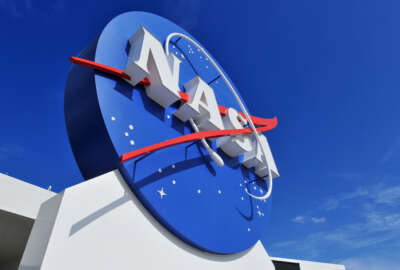Applying tech being used on the ISS toward a future mission to Mars
Voyager Space has entered into an agreement with NASA's Marshall Space Flight Center to help develop an airlock for the Mars Transit Vehicle.
Voyager Space has entered into an agreement with NASA’s Marshall Space Flight Center to help develop an airlock for the Mars Transit Vehicle, also referred to as Deep Space Transport. It’s a 12-month study that will look at the applying the concept of Voyager’s Bishop Airlock design, currently being utilized on the International Space Station, towards a future mission to Mars. To learn more, the Space Hour host Eric White spoke with Marshall Smith, Chief Technology Officer for Voyager Space.
Interview Transcript:
Marshall Smith So, basically, when I was working in NASA, and NASA has always been on the plan to go to Mars. Or, you know, if you go look back at the legislation back in 2010, you know that the end goal is to go to Mars, we are going to the moon, but all in process of going to Mars. So one of the things that that’s really important and going to Mars is you need to be able to keep the mass as low as possible, the amount of things that you push out to Mars and back, we have developed an airlock that we actually self-funded and put on the ISS International Space Station. One of the tasks that it does is ejects garbage, it gets garbage away, and we can point it wherever we want to and, and get garbage out of the ISS, which is a really big deal. And so, if you’re going to be traveling to Mars, and back for, you know, many, many months along the way, mass is really important. So, when we look at how do you get rid of the garbage, this is one of the ways you can do that. So, we’ve been talking with NASA, NASA has been talking to us Marshall Space Flight Center about the ability to take the Bishop Airlock and develop a smaller version of that that can be used on the Mars transit vehicle. That’s the vehicle that’s going to go take crew and cargo from here, from the Earth to Mars and back.
Eric White So, was it that feature of the Bishop Airlock design the ability to dispose of trash? That is, you know, in a controlled manner? Was that the main reason why you think that they are interested in it for this long journey where you know, the humans they’re going to generate some waste while they’re while they’re taking that trip?
Marshall Smith Yeah, actually, that is their primary reason. You know, obviously, the bishop airlock, we can talk about that in a minute, if you want about all the things it can do it can do payloads and launch payloads into space and those types of things. But when you’re on a trip between Earth and Mars, you’re probably more functional. I’m going to use it as a trash injection system. There are some other things that can be done with it as well. And we can we’re going to look at some of those opportunities as well. But I think that’s their primary interest.
Eric White Yes. And you did have that correct. I would like to get a little bit more into the actual Bishop Airlock design itself. What else can it do? And are there other things that I can do that would be utilized on a mission to Mars?
Marshall Smith Yeah, so let’s talk about Bishop a second, a second. First of all, as I said, Before, it was a self-funded program, you know, we looked at the ability to launch payloads and to do pilot and you know, a modified payload, do things with them and put them out and expose them to vacuum. And, you know, Voyager came up with this idea of building an airlock. And this is a very large airlock, actually, it’s about five times larger than the current size airlock, that is that is on the vehicle. On the ISS. It’s a four cubic meter bell shaped canister, if you will, that attaches the tranquility module on the ISS. It uses the ISS arm that came with the arm to go down and grab the canister, if you will, the Bishop Airlock, and we’ll pull it away. And they can actually move it around and point in any direction that that you want to maybe point at, particularly if you have payloads that want to look a certain direction, or you want to launch payloads in a certain direction, or if you wanted to launch trash so that it burns up appropriately, and then doesn’t get you know, in the way of hitting anything on the ISS or even being close to anything on the ISS or any operations that are going on. And use as a berthing port, which is different than a docking port. It’s actually much larger, it’s pretty large, I think it’s about six feet seven inches, or Americans are about two meters, or for Europeans of others. And the size itself is kind of a common berthing mechanism that CBM which allows it to be very large, you know, an astronaut can actually get in the, the actual and put his, his or her arms out. And, you know, stretch around and move. And one of the cool things about it is there’s a lot of volume in there. So we can actually put a lot of payloads inside this, we can work in a shirtsleeve environment, because when it’s actually on the ISS, there’s a hatch and the hatches opened up and so the crew can go in and work and assemble payloads and check things out and make sure everything’s good to go and close the hatch and then you can depress it, and the arm will then move it away and point it wherever it needs to be pointed. And the other thing that it has is the ability to actually have external payloads mounted to the side of it as well. for a longer duration type of activities that you want to do.
Eric White We’re speaking with Marshall Smith. He’s the chief technology officer for Voyager space. And so is this the I imagine this isn’t the sort of thing that was on the ISS when the ISS was first put up. I mean, the ISS is a giant Lego project anyway, it was this something that was put in after the ISS was already in orbit.
Marshall Smith Yeah, actually, it’s only been up for about four years or so three or four years, we launched this, this was an idea that we had, we went to NASA and said, hey, we would like to do this. So, this is actually self-funded, commercially owned and operated by border space, it’s one of the only commercial properties, they may be the only commercial property on the International Space Station that is owned by another company, not a government. So, we came in assets. And we believe this is a really good concept that can offer opportunities to do payloads and get more commercial activities going. And it’s done just that. And like I said, it’s been a very efficient way to use and expose systems to space and vacuum and to deploy payloads, etc. Those types of things.
Eric White And to throw a curiosity question in there, you had mentioned some of the reasoning why you would want to be able to aim where you’re actually shooting off any trash into space, you know, for obvious reasons, you don’t want to hit anything, but it was that you know, something that NASA was actually looking for. I know you said you approached them. But was that something that they were like, oh, wow, that would be a big help.
Marshall Smith Actually, that kind of developed, you know, we were coming at it from the standpoint of payloads and being able to deploy payloads and launch payloads in space. But the whole concept of getting rid of trash. Trash management is a really big activity on the International Space Station, because obviously, humans create a lot of trash. And we do the best we can to keep that down as much as possible. But the only time you can really get rid of trash is when you have a cargo ship come up, it brings on more cargo, and then you can pack the trash into the cargo ship, and then it can be deployed and burned up and in the atmosphere. Well, if there’s a way to get it out quicker and easier, then that’s better. So, we developed a squirt like if you will, a trash bag that we can actually put on the inside of the Bishop Airlock, and then turn around and deploy it and get rid of that. And that became very interesting to NASA, because it helped really helps dramatically with the trash management system.
Eric White It’s Venus’s problem now, right?
Marshall Smith It burns up. But if we’re on the way to Mars, then then obviously we’ll want to point it in a way that maybe gets incinerating the sun eventually, or something along those lines.
Eric White Gotcha. Okay. And so yeah, let’s talk about the future in that trip to Mars, the design for the new airlock would be categorized as the Red Knight. And allow me to oversimplify again, you said you want to know they want to a smaller version of the Bishop design is it just going to be a matter of just shrinking down every element to fit whatever vehicle is going to be used? Or are other things going to be factored in?
Marshall Smith Pretty much, you know, we’re looking to maintain the belt jar shape, and we have the form factor itself, the seals and mechanisms probably can be reused. We’re also going to look at some lessons learned from the ISS and dealing with you know, disposing wet garbage and those types of things. You know, when we, when we started doing it, we learned a few things, oh, we got to make a little modification here or there. So, we’re going to make some opportunity, the opportunity to put some upgrades in there and make sure that the system can operate as best it can in that environment. It like said it will be designed to be smaller, because, you know, on your way to Mars, you’re really just looking to probably eject trash maybe on a weekly basis. You know, because every grand you carry unnecessarily is a required skill to be the push that system along. So, we want to we want to get rid of the trashes relatively soon as possible.
Eric White And not so much worried about any payloads. Right? I imagine that nobody they’re not going to make a pit stop or anything along the way, are they?
Marshall Smith It’s kind of hard to make pit stops. Once you do what’s called a trans Mars Mars injection burner, TMI, you’re not really stopping because then you have to turn around and do a burn to slow yourself down. So that requires a lot of fuel, so there’s really no points to stop along the way.
Eric White Marshall Smith is Chief Technology Officer for Voyager space.
Copyright © 2025 Federal News Network. All rights reserved. This website is not intended for users located within the European Economic Area.
Eric White is news anchor and Federal Drive producer at Federal News Network.
Follow @FEDERALNEWSCAST






